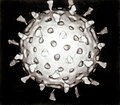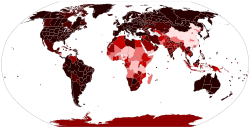Portal:Viruses
The Viruses Portal
Welcome!

Viruses are small infectious agents that can replicate only inside the living cells of an organism. Viruses infect all forms of life, including animals, plants, fungi, bacteria and archaea. They are found in almost every ecosystem on Earth and are the most abundant type of biological entity, with millions of different types, although only about 6,000 viruses have been described in detail. Some viruses cause disease in humans, and others are responsible for economically important diseases of livestock and crops.
Virus particles (known as virions) consist of genetic material, which can be either DNA or RNA, wrapped in a protein coat called the capsid; some viruses also have an outer lipid envelope. The capsid can take simple helical or icosahedral forms, or more complex structures. The average virus is about 1/100 the size of the average bacterium, and most are too small to be seen directly with an optical microscope.
The origins of viruses are unclear: some may have evolved from plasmids, others from bacteria. Viruses are sometimes considered to be a life form, because they carry genetic material, reproduce and evolve through natural selection. However they lack key characteristics (such as cell structure) that are generally considered necessary to count as life. Because they possess some but not all such qualities, viruses have been described as "organisms at the edge of life".
Selected disease
Myxomatosis is a disease of rabbits caused by Myxoma virus, a poxvirus in the genus Leporipoxvirus. The natural hosts are brush rabbits (Sylvilagus bachmani) in North America and tapeti (S. brasiliensis) in South and Central America, in which the myxoma virus causes only a mild disease, involving skin nodules. In European rabbits (Oryctolagus cuniculus), it causes a severe, often fatal, disease. Symptoms include fever, swelling of the eyelids and anogenital area, a mucopurulent ocular and nasal discharge, respiratory distress and hypothermia. Death generally occurs 10–12 days after infection. Myxoma virus is transmitted passively (without replication) by arthropod vectors, usually via the bites of mosquitoes and fleas, and also mites, flies and lice. It can also be transmitted by direct contact, and is shed in the ocular and nasal discharge and from eroded skin.
Myxoma virus was intentionally introduced in Australia, France and Chile in the 1950s to control wild European rabbit populations. This resulted in short-term 10–100-fold reductions in the rabbit population, followed by its recovery with the emergence of myxomatosis-resistant animals and attenuated virus variants. The introduction of myxomatosis is regarded as a classical example of host–pathogen coevolution following cross-species transmission of a pathogen to a naive host.
Selected image
CCR5 is a human membrane protein that acts as a secondary receptor for HIV, enabling the viral and cell membranes to fuse. People with two copies of a mutated Δ32 form of CCR5 are naturally resistant to infection by most strains of HIV, and the normal form is the target of entry inhibitors such as maraviroc.
Credit: Thomas Splettstoesser (18 July 2012)
In the news
26 February: In the ongoing pandemic of severe acute respiratory syndrome coronavirus 2 (SARS-CoV-2), more than 110 million confirmed cases, including 2.5 million deaths, have been documented globally since the outbreak began in December 2019. WHO
18 February: Seven asymptomatic cases of avian influenza A subtype H5N8, the first documented H5N8 cases in humans, are reported in Astrakhan Oblast, Russia, after more than 100,0000 hens died on a poultry farm in December. WHO
14 February: Seven cases of Ebola virus disease are reported in Gouécké, south-east Guinea. WHO
7 February: A case of Ebola virus disease is detected in North Kivu Province of the Democratic Republic of the Congo. WHO
4 February: An outbreak of Rift Valley fever is ongoing in Kenya, with 32 human cases, including 11 deaths, since the outbreak started in November. WHO
21 November: The US Food and Drug Administration (FDA) gives emergency-use authorisation to casirivimab/imdevimab, a combination monoclonal antibody (mAb) therapy for non-hospitalised people twelve years and over with mild-to-moderate COVID-19, after granting emergency-use authorisation to the single mAb bamlanivimab earlier in the month. FDA 1, 2
18 November: The outbreak of Ebola virus disease in Équateur Province, Democratic Republic of the Congo, which started in June, has been declared over; a total of 130 cases were recorded, with 55 deaths. UN
Selected article
RNA interference is a type of gene silencing that forms an important part of the immune response against viruses and other foreign genetic material in plants and many other eukaryotes. A cell enzyme called Dicer (pictured) cleaves double-stranded RNA molecules found in the cell cytoplasm – such as the genome of an RNA virus or its replication intermediates – into short fragments termed small interfering RNAs (siRNAs). These are separated into single strands and integrated into a large multi-protein RNA-induced silencing complex, where they recognise their complementary messenger RNA (mRNA) molecules and target them for destruction. This prevents the mRNAs acting as a template for translation into proteins, and so inhibits, or silences, the expression of viral genes.
RNA interference allows the entire plant to respond to a virus after a localised encounter, as the siRNAs can transfer between cells via plasmodesmata. The protective effect can be transferred between plants by grafting. Many plant viruses have evolved elaborate mechanisms to suppress this response. RNA interference evolved early in eukaryotes, and the system is widespread. It is important in innate immunity towards viruses in some insects, but relatively little is known about its role in mammals. Research is ongoing into the application of RNA interference to antiviral treatments.
Selected outbreak
The 1976 Zaire Ebola virus outbreak was one of the first two recorded outbreaks of the disease. The causative agent was identified as a novel virus, named for the region's Ebola River. The first identified case, in August, worked in the school in Yambuku, a small rural village in Mongala District, north Zaire. He had been treated for suspected malaria at the Yambuku Mission Hospital, which is now thought to have spread the virus by giving vitamin injections with inadequately sterilised needles, particularly to women attending prenatal clinics. Unsafe burial practices also spread the virus.
The outbreak was contained by quarantining local villages, sterilising medical equipment and providing protective clothing to medical personnel, and was over by early November. A total of 318 cases was recorded, of whom 280 died, an 88% case fatality rate. An earlier outbreak in June–November in Nzara, Sudan, was initially thought to be linked, but was shown to have been caused by a different species of Ebola virus.
Selected quotation
| “ | To help conceptualize the sheer number of viruses in existence, their current biomass has been estimated to equal that of 75 million blue whales (approximately 200 million tonnes) and, if placed end to end, the collective length of their virions would span 65 galaxies. | ” |
—Peter Simmonds
Recommended articles
Viruses & Subviral agents: bat virome • elephant endotheliotropic herpesvirus • HIV • introduction to viruses![]() • Playa de Oro virus • poliovirus • prion • rotavirus
• Playa de Oro virus • poliovirus • prion • rotavirus![]() • virus
• virus![]()
Diseases: colony collapse disorder • common cold • croup • dengue fever![]() • gastroenteritis • Guillain–Barré syndrome • hepatitis B • hepatitis C • hepatitis E • herpes simplex • HIV/AIDS • influenza
• gastroenteritis • Guillain–Barré syndrome • hepatitis B • hepatitis C • hepatitis E • herpes simplex • HIV/AIDS • influenza![]() • meningitis
• meningitis![]() • myxomatosis • polio
• myxomatosis • polio![]() • pneumonia • shingles • smallpox
• pneumonia • shingles • smallpox
Epidemiology & Interventions: 2007 Bernard Matthews H5N1 outbreak • Coalition for Epidemic Preparedness Innovations • Disease X • 2009 flu pandemic • HIV/AIDS in Malawi • polio vaccine • Spanish flu • West African Ebola virus epidemic
Virus–Host interactions: antibody • host • immune system![]() • parasitism • RNA interference
• parasitism • RNA interference![]()
Methodology: metagenomics
Social & Media: And the Band Played On • Contagion • "Flu Season" • Frank's Cock![]() • Race Against Time: Searching for Hope in AIDS-Ravaged Africa
• Race Against Time: Searching for Hope in AIDS-Ravaged Africa![]() • social history of viruses
• social history of viruses![]() • "Steve Burdick" • "The Time Is Now" • "What Lies Below"
• "Steve Burdick" • "The Time Is Now" • "What Lies Below"
People: Brownie Mary • Macfarlane Burnet![]() • Bobbi Campbell • Aniru Conteh • people with hepatitis C
• Bobbi Campbell • Aniru Conteh • people with hepatitis C![]() • HIV-positive people
• HIV-positive people![]() • Bette Korber • Henrietta Lacks • Linda Laubenstein • Barbara McClintock
• Bette Korber • Henrietta Lacks • Linda Laubenstein • Barbara McClintock![]() • poliomyelitis survivors
• poliomyelitis survivors![]() • Joseph Sonnabend • Eli Todd • Ryan White
• Joseph Sonnabend • Eli Todd • Ryan White![]()
Selected virus
Canine parvovirus type 2 (CPV2) is a non-enveloped, single-stranded DNA virus in the Parvoviridae family. The icosahedral viral capsid is only 20–26 nm in diameter, making it one of the smallest viruses. The genome is about 5000 nucleotides long. The virus is very similar to feline panleukopenia virus, another parvovirus, as well as mink enteritis and raccoon and fox parvoviruses. It infects dogs, wolves, foxes and other canids, big cats and occasionally domestic cats, but cannot infect humans.
A relatively new disease, CPV2 infection was first recognised in 1978 and rapidly spread worldwide. The virus is stable and highly infectious, being transmitted by contact with faeces, infected soil or contaminated objects. After ingestion, the virus replicates in the lymphoid tissue in the throat, then spreads to the bloodstream to infect cells of the lymph nodes, intestinal crypts and bone marrow, damaging the intestinal lining. The more common intestinal form of disease causes vomiting and severe, often bloody diarrhoea. The cardiac form affects puppies under 8 weeks, causing respiratory or cardiovascular failure; mortality can reach 91% in untreated cases. No specific antiviral drug is available. Prevention is by vaccination.
Did you know?
- ...that the elegant rice rat (pictured; top) sometimes carries a hantavirus that can cause a fatal disease in humans?
- ...that a quaranjavirus that can infect humans was discovered in 1953, but it took 60 years to classify it?
- ...that in 1918, infected crew members aboard HMS Mantua inadvertently spread the Spanish flu to Africa?
- ...that in the mid-1980s, some HIV patients pinned their hopes for survival on an experimental drug called HPA-23?
- ...that Li Zaiping and his research group were the first to sequence a viral genome in China?
Selected biography
Many well-known people have survived the paralytic disease polio. The earliest identified case might be Siptah (pictured), Egyptian pharaoh 1197–1191 BC, whose mummified remains have a deformed leg possibly from polio. Claudius, Roman emperor 41–54 AD, walked with a limp after a childhood disease that historians have hypothesised might have been polio. Novelist Sir Walter Scott suffered paralysis in one leg after a teething fever in 1773, which left him lame; his detailed account of his disease has allowed a retrospective diagnosis of polio to be made with confidence.
For many of those who survived it, paralytic polio was a life-changing experience. The disease can lead to permanent physical disability; Itzhak Perlman, for example, plays the violin seated. Others recover completely, with some going on to excel in sports; Ray Ewry became world's foremost standing jumper after childhood polio. Some survivors, including singer Ian Dury and actress Mia Farrow, have campaigned for polio eradication or for disability rights.
In this month
5 June 1981: First report of HIV/AIDS (symbol pictured) appeared in medical literature
6 June 1997: Gene silencing in plants shown to be a viral defence mechanism
7–13 June 1962: Donald Caspar and Aaron Klug proposed the quasi-equivalence principle of virus structure
7–13 June 1962: André Lwoff proposed a viral classification scheme based on nature of genome, type of symmetry and presence of envelope
7–13 June 1962: George Hirst proposed that the influenza virus genome is segmented
9 June 1981: The American Society for Virology was founded
13 June 2012: First case of Middle East respiratory syndrome coronavirus (MERS-CoV) occurred in Saudi Arabia
18 June 1981: A vaccine against foot-and-mouth disease was the first genetically engineered vaccine
21 June 1996: Nevirapine approved, first NNRTI for HIV/AIDS
26 June 1993: Clinical trial of hepatitis B virus drug fialuridine terminated; the drug caused several fatalities due to lactic acidosis
28 June 2011: FAO declared rinderpest eradicated
30 June 1985: Ryan White was denied re-admittance to his school after an AIDS diagnosis, in a case that changed public perceptions of the disease
Selected intervention
Several human papillomavirus (HPV) vaccines, including Cervarix and Gardasil, have been approved to protect against infections with particular types of HPV, associated with cervical and other cancers. All vaccines protect against the high-risk HPV types 16 and 18. Gardasil is a quadrivalent vaccine that additionally protects against low-risk HPV-6 and -11, which are associated with most cases of genital warts. A second-generation nine-valent Gardasil vaccine protects against five additional high-risk HPV types. It is estimated that the vaccines may prevent 70% of cervical cancer, 80% of anal cancer, 60% of vaginal cancer, 40% of vulvar cancer and possibly some oropharyngeal cancers. Protection lasts for at least 8–9 years. Some advocate giving Gardasil to men and boys with the primary aim of protecting their female sexual partners; others consider vaccinating only women and girls to be more cost effective. The licensed vaccines are subunit vaccines, containing only the L1 capsid protein of the virus, which self-assembles into virus-like particles. They are not effective in people already infected with HPV. Research is ongoing into therapeutic HPV vaccines including the viral oncoproteins, E6 and E7, but none has yet been licensed.
Subcategories
Subcategories of virology:
Topics
Things to do
- Comment on what you like and dislike about this portal
- Join the Viruses WikiProject
- Tag articles on viruses and virology with the project banner by adding {{WikiProject Viruses}} to the talk page
- Assess unassessed articles against the project standards
- Create requested pages: red-linked viruses | red-linked virus genera
- Expand a virus stub into a full article, adding images, citations, references and taxoboxes, following the project guidelines
- Create a new article (or expand an old one 5-fold) and nominate it for the main page Did You Know? section
- Improve a B-class article and nominate it for Good Article
 or Featured Article
or Featured Article status
status - Suggest articles, pictures, interesting facts, events and news to be featured here on the portal
WikiProjects & Portals
 WikiProject Viruses
Related WikiProjects
WikiProject Viruses
Related WikiProjects
Medicine • Microbiology • Molecular & Cellular Biology • Veterinary Medicine
Related PortalsAssociated Wikimedia
The following Wikimedia Foundation sister projects provide more on this subject:
-
Commons
Free media repository -
Wikibooks
Free textbooks and manuals -
Wikidata
Free knowledge base -
Wikinews
Free-content news -
Wikiquote
Collection of quotations -
Wikisource
Free-content library -
Wikispecies
Directory of species -
Wikiversity
Free learning tools -
Wiktionary
Dictionary and thesaurus



















